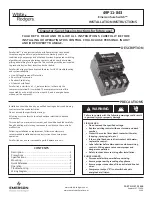
5-10
Applications
Date Code 20000421
SEL-251, -2, -3 Instruction Manual
effectively, TR(1246)
= [
51NT
*NOT(
IN5
)]+[
50NL
*
52AT
*NOT(
IN5
)]+...
which reduces to: TR(1246) = [
51NT
+(
50NL
*
52AT
)]*NOT(
IN5
)+...
close TRIP output contacts = TR + ...
If the control wiring into input IN5 is accidentally open circuited (IN5 is de-energized; IN5=0),
elements supervised by IN5 are still enabled, enhancing dependability.
Disable Ground/Residual Overcurrent Elements with Torque Control Input
When a torque control input is energized, selected overcurrent elements are enabled for
operation.
When a torque control input is de-energized, selected overcurrent elements are disabled from
operation. In such a state, selected instantaneous overcurrent elements do not pick up if current
exceeds their pickup settings. Selected definite-time overcurrent and time-overcurrent elements
do not start timing when current exceeds pickup settings.
For example, assign input IN4 to function as the ground/residual overcurrent element torque
control input. Using the SET G command (global settings):
IN4
= TCG
(external torque control input
for ground/residual elements)
Then externally torque control the ground/residual time-overcurrent element
51NT
.
Using SEL
OGIC
Control Equations:
TR(1246) =
51NT
+...
(TR is the programmable trip condition)
ETC(1)
=
51NP
(choose elements to be externally torque controlled)
close TRIP output contacts = TR + ...
Setting ETC(1) lists overcurrent pickups to be externally torque controlled. Element
51NP
is the
pickup for
51NT
. If
51NP
is torque controlled,
51NT
is also torque controlled. This is how the
relay achieves torque controlling for time-overcurrent and definite-time overcurrent elements via
pickups.
In this example, energizing input IN4 enables the
51NT
element; de-energizing input IN4
disables the
51NT
element.
If IN4 = !TCG, the opposite sense is on the input. De-energizing input IN4 enables the
51NT
element; energizing input IN4 disables the
51NT
element.
Implementation of this scheme using the external torque control function is much more efficient
than the previous two examples. You can use the SEL
OGIC
Control Equations variables saved to
implement other schemes as needed.
















































